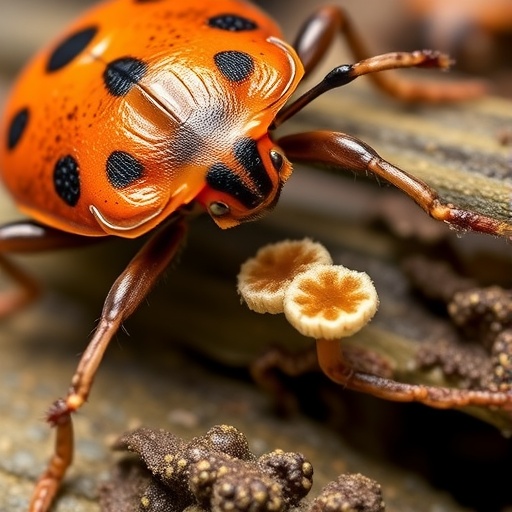In an astonishing discovery that redefines our understanding of insect anatomy and symbiosis, researchers have uncovered a unique fungal nursery hidden within the hindlegs of female dinidorid stinkbugs, challenging the long-held assumption that these structures served as auditory organs. Traditionally, the conspicuously enlarged surface on the hindleg of female dinidorid stinkbugs has been identified as a tympanal organ—an evolutionary adaptation seen in various insect species for detecting sound. However, pioneering investigations into the Japanese species Megymenum gracilicorne reveal this organ is instead a sophisticated fungal symbiotic hub, instrumental in safeguarding the next generation against parasitic threats.
Detailed morphological analyses showed that what was presumed to be a thin, sensitive tympanal membrane is, in fact, a robust cuticular surface densely perforated by thousands of tiny pores. These microscopic openings are conduits for glandular secretions, which nurture the growth of symbiotic fungal hyphae directly on the insect’s leg. This fungal symbiosis is far from a passive association; it represents an active, evolved mechanism whereby female stinkbugs coat their freshly laid eggs with a living fungal shield.
The ecological implications of this discovery are profound. Parasitic wasps are notorious for exploiting stinkbug eggs, depositing their own larvae inside and effectively hijacking the stinkbug’s reproductive success. However, the fungal hyphae emanating from the leg organ form a physical barrier that deters such parasitism. Behavioral observations and controlled experiments demonstrated that when eggs are fully smeared with fungal filaments, parasitic wasps are unable to oviposit successfully. In contrast, eggs that were stripped of these fungal coverings—or those laid by females with surgically removed hindlegs—experienced dramatically elevated rates of parasitism.
Molecular identification of the fungal constituents uncovered a diverse assemblage belonging predominantly to the Cordycipitaceae family. This group typically includes insect pathogens, yet fascinatingly, the fungi associated with stinkbug hindlegs appear to adopt a low-pathogenicity profile. This ensures a benign or even beneficial interaction with the host insect and contrasts starkly with their closely related pathogenic relatives. Notably, these fungi do not infect the parasitic wasps, implying that the defensive role is purely mechanical rather than chemical or microbial antagonism.
This symbiotic system holds remarkable evolutionary significance. Unlike typical insect-fungus associations—often limited to gut symbionts or external colonies—this previously unknown organaceous adaptation showcases a direct morphological specialization for symbiont cultivation and vertical transmission. The intimate integration of fungal propagation into the anatomy and reproductive behavior of the stinkbug signals a sophisticated mutualism refined by millions of years of co-evolution. Such innovations illustrate the limits of traditional categorizations of insect organs and underscore the multifaceted roles symbiotic fungi can play beyond nutrition or digestion.
The research also extends beyond Megymenum gracilicorne. Examination of multiple species within the family Dinidoridae revealed a consistent presence of this female-specific hindleg structure and associated egg-smearing behavior, indicating a widespread symbiotic trait within this lineage. This suggests that the fungal nursery and its protective function may be a defining feature that has contributed to the evolutionary success—and survival—of these stinkbugs in the face of relentless parasitic pressure.
From a biomechanical perspective, the leg organ represents a novel, natural design for symbiont nurturing. The cuticle-based surface provides structural durability, while the innumerable pores facilitate fungal secretion and anchorage without compromising the insect’s mobility or leg function. This design balances the competing demands of symbiont cultivation and physical robustness, ensuring that female stinkbugs can both carry the fungal community and perform their daily activities unencumbered.
The methodology employed by the researchers incorporated a multidisciplinary approach, blending behavioral ecology, molecular biology, microscopy, and experimental manipulation. Controlled amputation experiments revealed causality between the presence of the hindleg organ and parasitism rates. Microscopic imaging elucidated the anatomical features, while fungal isolation and DNA sequencing characterized the symbiotic assemblage with high precision. Together, these techniques illuminate a complex biological phenomenon previously obscured by assumptions rooted in comparative anatomy.
In conclusion, this groundbreaking study redefines the functional landscape of insect hearing organs, demonstrating that what appeared to be an auditory apparatus is, in fact, a specialized structure facilitating fungal cultivation for offspring protection. It prompts a re-examination of other insect morphological structures potentially misinterpreted and highlights the intricate evolutionary interplay between insects and their microbial partners. The defensive fungal symbiosis uncovered here exemplifies nature’s inventive strategies to combat parasitism and preserve reproductive success through cooperative interactions.
As this symbiotic relationship unfolds at the intersection of entomology, mycology, and evolutionary biology, it heralds new avenues for studying symbioses that transcend nutrition and extend into defensive ecology. Understanding such systems could inspire biomimetic applications in pest control and deepen comprehension of natural defense mechanisms within ecosystems.
This revelation invites scientists to reconsider the subtle and often overlooked alliances that insects maintain with microorganisms. Beyond the immediate biological interest, it also bears potential implications for agricultural pest management, given the widespread impact of parasitic wasps on stinkbug populations, some of which are crop pests. Leveraging natural fungal defenses could offer environmentally sustainable strategies for mitigating parasitic wasp damage without reliance on chemical insecticides.
Ultimately, the discovery that female dinidorid stinkbugs have evolved a specialized organ devoted to cultivating protective fungal shields reveals an extraordinary example of nature’s resourcefulness. It challenges entrenched notions about insect organ function and opens new horizons for exploring symbiotic adaptations that have evolved to secure offspring survival amidst a hostile biological landscape.
Subject of Research: Defensive symbiosis between dinidorid stinkbugs and fungal hyphae located on female hindlegs used to protect eggs from parasitic wasps
Article Title: Defensive fungal symbiosis on insect hindlegs
News Publication Date: 16-Oct-2025
Web References: DOI: 10.1126/science.adp6699
Keywords: dinidorid stinkbugs, fungal symbiosis, hindleg organ, parasitic wasps, Cordycipitaceae, insect defense mechanisms, symbiotic fungi, insect anatomy, evolutionary biology




